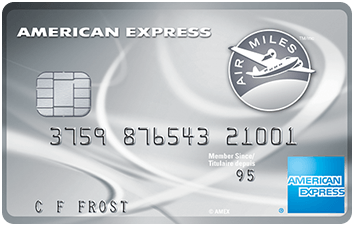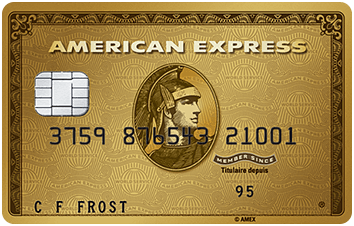The credit card reward conundrum: should you collect Air Miles or rewards points?
By: Maureen Genore on January 12, 2017
*This post was updated on Feb 20, 2020 to reflect an update made to the American Express® AIR MILES® Platinum Credit Card.*
I have a confession: using a credit card for all of my purchases freaks me out. A tad dramatic, I know, but as readers learned last month, I haven’t always been great with my finances. The idea of being able to spend money that I haven’t made yet makes me feel uneasy. I currently use my two credit cards sparingly and make most purchases with my debit card.
But after overhearing a co-worker brag about their free vacation flight paid for with credit card points, I realized maybe I’m missing out. That set me off on a quest to find a card that will help me pay for my next trip to a sunny locale.
The problem: when I started weighing my options, I realized they were endless. There are Air Miles cards, Aeroplan cards, and then points cards that you can use to pay for travel.
That led me to ask: what, exactly, should I be collecting to help pay for my flights and hotels. Air Miles? Reward points?
Below, I compare two cards that appeal to me. This comparison factors in each card’s sign-up bonus, plus how much I’ll be rewarded after spending $1,000 each month for a year. Here’s what I found.
The case for collecting Miles
Perhaps the most obvious type of card for me to get would be an Air Miles credit card. (For those who don’t know — Air Miles is a loyalty program that allows you to collect Miles to redeem for travel, merchandise, and more).
Here’s an example of a popular American Express Air Miles card that you can use to collect Miles:
American Express® AIR MILES® Platinum Credit Card
Annual Fee: $120
Interest Rate: 19.99%
Sign-Up Bonus: 3,000 AIR MILES® Reward Miles when you charge a total of $1,500 in purchases within your first three months of cardmembership
Rewards: Earn one reward mile for every $10 in card purchases at AIR MILES® sponsors, earn one reward mile for every $10 in purchases at other eligible grocery stores, gas stations, and drugstores in Canada, and earn one reward mile for every $15 in purchases everywhere else
If I were to spend $1,000 per month for one year ($600 at AIR MILES® sponsors and eligible gas stations, grocery stores and drugstores and $400 elsewhere), I would accumulate 1,040 AIR MILES®. If I were to add on the sign-up bonus, I’d have a total of 3,040 AIR MILES® at the end of the year.
The case for collecting points
In contrast, instead of an Air Miles card, I could get a rewards card where I’d collect points rather than Miles.
Here’s an example of a popular American Express rewards card that allows you to collect points:
American Express® Gold Rewards Card
Annual Fee: $0 intro year, $150 after the first year
Interest Rate: 30% annual interest rate applies to balances not paid in full
Sign-Up Bonus: 25,000 Membership Rewards® points by making $1,500 in purchases in the first three months of cardmembership
Rewards: Earn 2 points for every $1 in purchases at eligible gas stations, grocery stores and drugstores in Canada, earn 2 points for every $1 in purchases for eligible travel purchases, including flights, hotels, car rentals, cruises, and earn 1 point for every $1 in purchases everywhere else
If I were to spend $1,000 per month for one year ($600 at eligible gas stations, grocery stores and drugstores and $400 elsewhere), I would accumulate 19,200 points. If I were to add on the sign-up bonus, I’d have a total of 44,200 rewards points at the end of the year.
So, which will take you further?
Let's take a look at what we can get by redeeming the 3,040 Air Miles or 44,200 rewards points for travel.
Air Miles Rewards
Figuring out the best way to redeem your Air Miles is, in a word, complicated. You really have to do your research to find the best deals — and sometimes the best deals might not be for travel.
Nonetheless, I revived my Air Miles account to view the reward options. Here is how many Miles it would cost to travel from Toronto to the following cities, during the low season (when flights are the cheapest). The dates I checked were January 15 - January 21, 2017.
Ottawa - 1200 Miles, plus $163.61 in taxes and fees (Without Miles, this flight, with fees, would be $498.61 in cash)
New York - 1300 Miles, plus $155.35 in taxes and fees ($334.34 without Miles)
Boston - 1300 Miles, plus $159.75 in taxes and fees ($426.74 without Miles)
Halifax - 1,700 Miles, plus $214.24 in taxes and fees ($726.24 without Miles)
Points Rewards
Redeeming points for travel was a little bit easier to understand. You can redeem 1,000 points for $10 in travel credit. With the 44,200 points I’d have by the end of the year, I’d have a travel credit of $442. This credit can be used to pay for taxes and fees — a big difference between the two programs.
Let’s compare how much I’d have to pay out of pocket to travel using Miles and points:
| City | Using Miles | Using Points |
| Ottawa | $163.61 | $56.61 |
| New York | $155.35 | $0, ($107.66 credit left over) |
| Boston | $159.75 | $0, ($15.26 credit left over) |
| Halifax | $214.24 | $284.24 |
So, which program is better? Well, as you can probably tell, it gets a bit tricky to figure out. On a strictly value basis, you can actually get more money if you go with Air Miles. With the more than 3,000 Miles that’d you’d accumulate in your first year, you’d actually be able to redeem them for quite a bit more than the $442 you’d get from the rewards card.
But this is where it gets complicated. The Miles are far less flexible than the points are, and you always have to pay the taxes and fees when you travel. If you look at the comparison above, you can see that you’d actually end up paying more out of pocket if you used Miles for three of these flights.
If it’s important to you to have the luxury of taking a completely free flight, you’re better off going with the points card. The points card also beats out the Miles when you look at the redemption options available — there are far more options to choose from.




